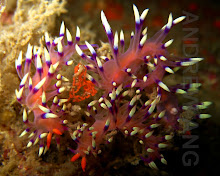With many reef predators and prey occupying the same reef habitat, many reef creatures would rather hide when threatened and employ deception, mimicry and camouflage to disguise themselves as a first line of defense. Some even show off bold, bright colours to announce that they are poisonous. Others will distract predators with inks, lights or ejected parts. When attempts to evade the attacker is futile, they will resort to different means to protect themselves, including using predatory mechanisms as a last line of defense.
Slow-moving creatures like urchins, sea stars and cone shells use chemicals or poisons in combination with darts, spines and needles to protect themselves.
Stonefish and scorpionfish carry lethal venom on dorsal spines, rays carry venom in their stings, while boxfish, pufferfish, soapfish and toadfish secrete skin poisons.
Jellyfish, corals, anemones and hydroids use stinging cells called nematocysts to fire a mass of minute harpoons containing venom to stun and kill their prey.
Some species of octopus have venom in their saliva. For example, the bite from the tiny blue ringed octopus can be lethal to humans.
Some innocent-looking reef fishes are equipped with self-defense mechanisms. Squirrelfish and angelfishes have spines on their gill-covers which are venomous in some species of squirrelfish. Surgeonfish have a retractable blade or scalpel at the base of the tail which it uses to slash would-be attackers.
Some sea cucumbers eject white cuiverian tubules when irritated. These contain toxins that can cause blindness when it comes into contact with the eye - so make sure you wash your hands after handling them. Others are able to cast off parts of their gut as sacrificial bait or emit sticky filaments to entangle would-be predators, including humans. These body parts are regenerated.
Barracudas, sharks, eels and triggerfishes have powerful jaws for biting while the mantis shrimp uses its deadly claws to spear or smash their victims. Electric rays and electric eels can deliver high-voltage electric shocks to stun its prey.
-AA-
Tuesday, July 22, 2008
Subscribe to:
Post Comments (Atom)

















































No comments:
Post a Comment